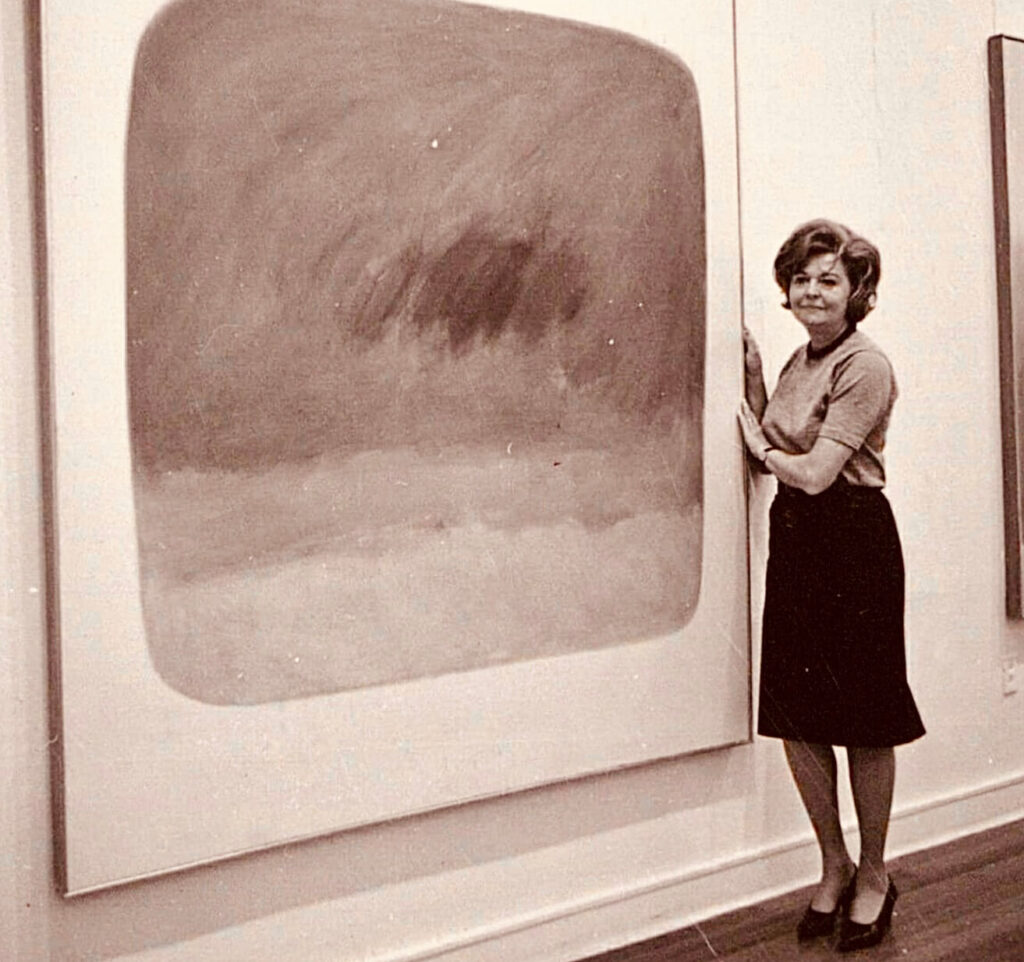Ida Kohlmeyer
Ida Kohlmeyer (1912-1997) was a prominent American abstract artist whose vibrant and dynamic works left an indelible mark on the world of contemporary art. Known for her distinctive style that fused elements of Abstract Expressionism and Color Field painting, Kohlmeyer developed a unique visual language that resonated with viewers. This biography explores Kohlmeyer’s life, artistic evolution, and two of her most significant artworks, highlighting her lasting impact on the art world.

Early Life and Education
Ida Rittenberg Kohlmeyer was born on November 3, 1912, in New Orleans, Louisiana. She grew up in a culturally rich environment that was steeped in the traditions and vibrant atmosphere of the American South. Despite her early interest in art, Kohlmeyer did not pursue formal training until much later in life. Instead, she focused on her family, marrying Hugh Kohlmeyer in 1934 and raising two daughters.
It was not until her mid-thirties that Kohlmeyer began to seriously explore her passion for art. In 1947, she enrolled in Newcomb College (now part of Tulane University) in New Orleans, where she studied under several influential artists, including Pat Trivigno and Xavier Gonzalez. She earned a Bachelor of Fine Arts degree in 1950 and a Master of Fine Arts degree in 1956. This period marked the beginning of her formal artistic education and the foundation of her future career.
Artistic Development and Influences
After completing her education, Kohlmeyer continued to develop her artistic skills and experiment with different styles and techniques. Her early work was influenced by the figurative and landscape traditions of the American South, but she quickly moved towards abstraction. A pivotal moment in her career came in the late 1950s when she studied under the renowned German-American artist Hans Hofmann in Provincetown, Massachusetts.
Hofmann’s teachings had a profound impact on Kohlmeyer’s artistic development. His emphasis on color, form, and the expressive potential of abstraction inspired her to explore new ways of creating art. Hofmann’s influence is evident in Kohlmeyer’s bold use of color and dynamic compositions, which became hallmarks of her mature style.
Emergence as an Abstract Artist
By the early 1960s, Kohlmeyer had fully embraced abstraction and began to gain recognition for her innovative works. Her compositions were characterized by vibrant colors, intricate patterns, and a sense of movement and energy. She often used a grid-like structure to organize her compositions, creating a sense of order amidst the dynamic forms and colors.
Kohlmeyer’s work from this period reflects her interest in both Abstract Expressionism and Color Field painting. She was particularly influenced by the works of artists such as Mark Rothko and Jackson Pollock, whose emphasis on color and gesture resonated with her own artistic vision. However, Kohlmeyer developed a distinct style that set her apart from her contemporaries, blending elements of both movements to create a unique visual language.
Important Artworks
“Cluster Series #14” (1972)
“Cluster Series #14” is one of Ida Kohlmeyer’s most notable works, created as part of her acclaimed Cluster series. The painting exemplifies her mature style, characterized by vibrant colors, dynamic forms, and a sense of movement and energy. The composition features a grid-like structure, with each square or rectangle containing a unique combination of colors and shapes.
The use of color in “Cluster Series #14” is particularly striking, with bold reds, blues, yellows, and greens creating a sense of vibrancy and dynamism. The composition is both orderly and chaotic, with the grid providing a sense of structure while the individual forms and colors create a sense of movement and spontaneity. This interplay between order and chaos is a hallmark of Kohlmeyer’s work, reflecting her ability to balance structure with expressive freedom.
“Cluster Series #14” highlights Kohlmeyer’s mastery of color and form, as well as her ability to create compositions that are both visually compelling and emotionally resonant. The painting invites viewers to explore the intricate patterns and dynamic forms, offering a rich and immersive visual experience.
“Symbols II” (1982)
“Symbols II” is another significant work in Kohlmeyer’s oeuvre, created as part of her Symbols series. This series marked a departure from her earlier grid-based compositions, as she began to explore the use of abstract symbols and forms to create meaning and convey emotion. “Symbols II” features a collection of abstract shapes and symbols arranged in a loose, organic composition.
The use of symbols in this work reflects Kohlmeyer’s interest in the expressive potential of abstract forms. The shapes are not representational, but they evoke a sense of meaning and emotion through their arrangement and interaction. The composition is characterized by bold, contrasting colors and dynamic forms, creating a sense of movement and energy.
“Symbols II” exemplifies Kohlmeyer’s ability to create compositions that are both abstract and expressive, using color and form to convey a sense of meaning and emotion. The work invites viewers to engage with the symbols and explore their own interpretations, reflecting Kohlmeyer’s belief in the power of abstraction to communicate on a deeper, more intuitive level.
Later Career and Legacy
Throughout the 1970s and 1980s, Kohlmeyer continued to experiment with new techniques and materials, expanding her artistic practice to include sculpture and installation art. Her work from this period reflects a continued interest in color, form, and the expressive potential of abstraction. She often used a variety of materials, including wood, metal, and fabric, to create dynamic, three-dimensional compositions.
Kohlmeyer’s contributions to contemporary art were recognized with numerous awards and honors, including a Guggenheim Fellowship in 1973 and a National Endowment for the Arts Fellowship in 1986. Her work has been exhibited in major museums and galleries around the world, including the Museum of Modern Art in New York, the Whitney Museum of American Art, and the New Orleans Museum of Art.
Personal Life and Philosophy
Ida Kohlmeyer’s personal life was marked by her dedication to her art and her commitment to her family. Despite the challenges of balancing her career with her responsibilities as a wife and mother, she remained committed to her artistic practice and continued to create and exhibit her work throughout her life.
Kohlmeyer viewed her work as a continual process of experimentation and discovery. She believed in the importance of pushing the boundaries of art and challenging conventional notions of beauty and form. Her philosophy of art emphasized the importance of color, movement, and space, as well as the need for artists to continually innovate and explore new possibilities.
Legacy and Influence
Ida Kohlmeyer’s legacy as an artist lies in her ability to create a unique visual language that combines color, form, and space in innovative ways. Her groundbreaking abstract works and her continued experimentation with new techniques and materials have left a lasting impact on the field of contemporary art.
Kohlmeyer’s influence extends beyond her own work, as she has inspired generations of artists to push the boundaries of their practice and to explore new possibilities in abstract art. Her contributions to the Abstract Expressionist and Color Field movements have earned her a place among the great artists of the 20th century.
Conclusion
Ida Kohlmeyer’s artistic journey is a testament to her creativity, resilience, and profound understanding of color and form. Through her innovative use of abstraction and her dynamic compositions, she created a body of work that continues to inspire and challenge viewers. “Cluster Series #14” and “Symbols II” are just two examples of her ability to convey complex ideas and emotions through abstract forms and vibrant colors. Kohlmeyer’s legacy as a master of abstract art ensures that her work will continue to resonate with audiences for years to come.



